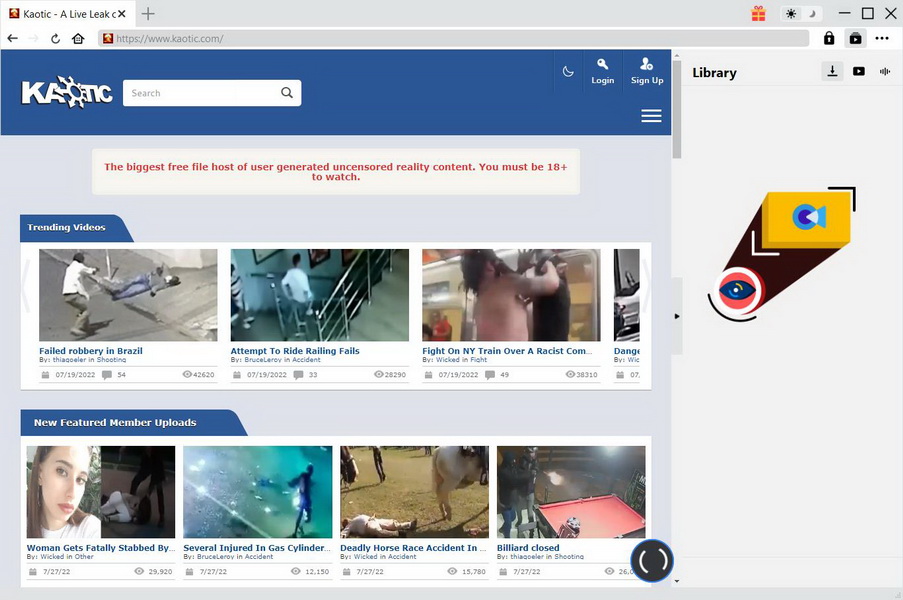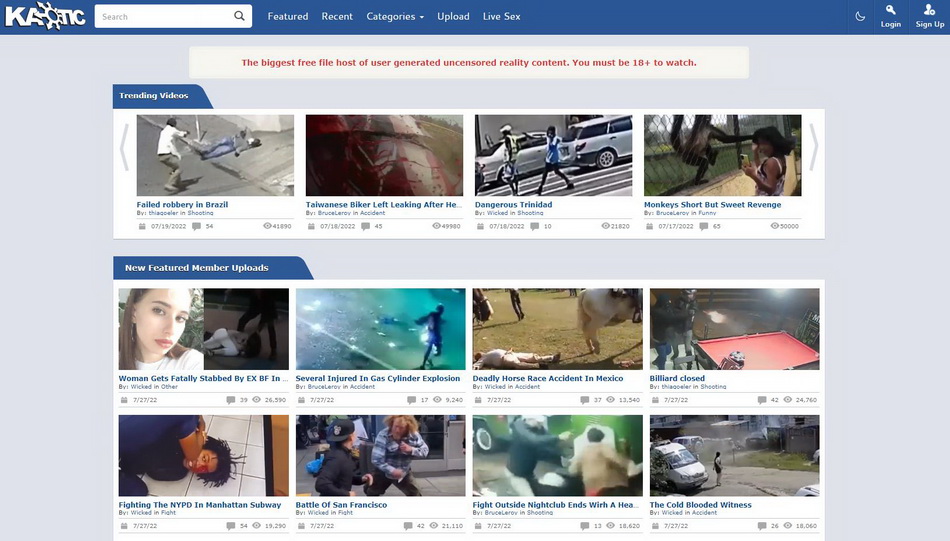Liveleak SHUT DOWN?! + Alternatives For Shocking Videos
Have you ever wondered where the internet draws the line? The internet landscape, once a boundless frontier of information and expression, is constantly being reshaped, especially when it comes to content that pushes boundaries. The closure of Liveleak, a website notorious for showcasing graphic violence and uncensored content, marks a significant shift in this landscape, raising questions about the future of online freedom and the ethical responsibilities of digital platforms.
After fifteen years of operation, Liveleak, a platform that dared to host content deemed too extreme for mainstream sites, has ceased operations. Its founder, Hayden Hewitt, cited a variety of factors for the decision, but the overarching theme was the evolving nature of the internet and the increasing challenges of maintaining a platform dedicated to unfiltered reality. Liveleak carved a niche for itself by presenting a raw, often disturbing, view of the world, attracting a dedicated, albeit controversial, audience. But its demise also signals a broader trend: the growing pressure on online platforms to moderate content, combat misinformation, and address concerns about the psychological impact of exposure to graphic material.
| Category | Information |
|---|---|
| Name | Hayden Hewitt |
| Occupation | Founder of Liveleak |
| Years Active | 2006-2021 (Liveleak Era) |
| Known For | Founding and Operating Liveleak |
| Website | The Register Article on Liveleak Shutdown |
The void left by Liveleak has inevitably led users to seek alternatives. A quick search reveals a number of platforms willing to fill the space, each with its own approach to content moderation and community standards. Some sites, like those catering to the "abruptchaos" community (boasting 2.4 million subscribers), offer videos that capture moments of unexpected and often humorous mayhem. These platforms, while still featuring chaotic content, generally steer clear of the graphic violence that defined Liveleak.
- What Is Masa49 Exploring The Buzz Its Impact Trends
- Filmyfly Your Guide To Bollywood South Indian Movies Online
However, a darker side of the internet still exists, readily accessible to those who seek it. Sites advertising themselves as the "premier destination for those who dare to explore the darker, more disturbing side of visual content" offer a glimpse into this world. These platforms often showcase "events and scenarios you won't find anywhere else," promising to push the boundaries of the ordinary. The explicit nature of the content is often a key selling point, with some sites even advertising "free hardcore sex" to attract viewers.
The presence of such content raises difficult questions about freedom of speech, censorship, and the potential harm caused by exposure to extreme material. While some argue that adults have the right to access whatever content they choose, others contend that platforms have a moral responsibility to protect users from potentially traumatizing or harmful content. The debate is further complicated by the fact that different societies have different cultural norms and legal frameworks regarding online content. What is considered acceptable in one country may be illegal or highly offensive in another.
The closure of Liveleak and the rise of alternative platforms highlight the ongoing struggle to balance freedom of expression with the need for responsible content moderation. While mainstream platforms like YouTube and Facebook have implemented stricter policies to combat hate speech, misinformation, and graphic violence, a number of smaller sites continue to operate on the fringes, catering to niche audiences with a taste for the extreme. These platforms often operate with minimal oversight, raising concerns about the potential for abuse and exploitation.
- Priscilla Love Van Winkle What You Didnt Know Daughter Of Vanilla Ice
- What Is Masa49 Meaning History More
The allure of uncensored content is undeniable. For some, it represents a form of rebellion against mainstream media and its perceived biases. For others, it's a way to confront uncomfortable truths about the world, to witness the raw realities of life and death without the sanitizing filter of traditional media. However, the potential psychological impact of exposure to graphic content cannot be ignored. Studies have shown that repeated exposure to violence can lead to desensitization, increased aggression, and even post-traumatic stress disorder.
The challenge for online platforms is to find a way to balance freedom of expression with the need to protect users from harm. This requires a nuanced approach that takes into account the context of the content, the potential impact on viewers, and the evolving norms of online behavior. It also requires ongoing dialogue between platforms, policymakers, researchers, and the public to develop effective strategies for addressing the challenges posed by extreme content.
The existence of sites like "deep gore tube" and "Livegore," which specialize in "uncensored" and "bizarre" videos, underscores the persistent demand for content that pushes boundaries. These platforms often market themselves as alternatives to mainstream media, offering viewers a chance to "explore the unfiltered reality of life and death." However, the content they host often includes graphic violence, disturbing imagery, and potentially illegal material. The operators of these sites often argue that they are simply providing a platform for free expression, but critics contend that they are profiting from human suffering.
Kaotic, another platform that has gained notoriety for its "shocking, bizarre, and uncensored videos," exemplifies the challenges of moderating extreme content. The platform positions itself as a "haven for users seeking extreme and unconventional content," catering to those "interested in exploring raw and unfiltered human experiences." However, the content hosted on Kaotic often includes graphic violence, hate speech, and other forms of objectionable material. The platform's moderation policies have been criticized for being inconsistent and ineffective, leading to concerns about the potential harm caused by exposure to its content.
The closure of Liveleak may have marked the end of an era, but it has not eliminated the demand for uncensored content. A number of alternative platforms have emerged to fill the void, each with its own approach to content moderation and community standards. As these platforms continue to evolve, it is crucial to engage in a thoughtful and informed discussion about the ethical responsibilities of online platforms and the potential impact of extreme content on individuals and society as a whole.
The internet's underbelly continues to churn, with platforms like the aforementioned vying for the attention of those seeking the unvarnished, often disturbing, realities that mainstream media shies away from. The constant cat-and-mouse game between content creators, platform moderators, and regulators underscores the complexities of managing online content in a world where tastes, ethics, and legal frameworks vary widely.
One must also consider the "abruptchaos" phenomenon, a genre of video that has found a large audience. This content, often shared in online communities, captures moments of unexpected and chaotic events, frequently with a comedic or ironic twist. While not necessarily graphic or violent, this type of content highlights the human fascination with the unpredictable and the absurd. It also raises questions about the ethics of recording and sharing such moments, particularly when they involve individuals who may not be aware of being filmed or who may be in vulnerable situations.
The debate over online content moderation is further complicated by the issue of "true crime" videos. These videos, often taken from across the world, document real-life crimes and their aftermath. While some argue that these videos serve an important purpose by shedding light on criminal activity and promoting public awareness, others contend that they can be exploitative and sensationalistic. The potential for these videos to traumatize viewers or glorify violence is also a significant concern.
The proliferation of platforms dedicated to extreme content raises important questions about the role of technology companies in shaping our online experience. Should these companies be held responsible for the content hosted on their platforms? Should they be required to actively monitor and remove objectionable material? Or should they be allowed to operate as neutral platforms, providing a space for free expression regardless of the content? These are complex questions with no easy answers, and the debate over online content moderation is likely to continue for the foreseeable future.
Ultimately, the future of online content moderation will depend on a combination of technological innovation, policy changes, and societal norms. As technology evolves, new tools and techniques may emerge to help platforms identify and remove objectionable material more effectively. Policymakers may enact new laws and regulations to clarify the responsibilities of online platforms and to protect users from harm. And society as a whole may develop a greater understanding of the potential impact of online content and a stronger commitment to promoting responsible online behavior.
The ongoing saga of Liveleak and its successors serves as a stark reminder of the challenges and complexities of navigating the digital landscape. As we continue to explore the boundless possibilities of the internet, it is crucial to remain mindful of the ethical considerations and the potential consequences of our online actions. Only through thoughtful dialogue, responsible innovation, and a commitment to protecting the well-being of all users can we create a more positive and productive online environment.
The closure of Liveleak doesn't erase the appetite for the raw, unfiltered, and sometimes unsettling content it provided. It merely shifts the landscape, forcing users and platforms to adapt. The question isn't whether this kind of content will exist, but where and how it will be presented, and what safeguards will be in place to mitigate potential harm. The internet, after all, is a reflection of humanity itself capable of both extraordinary creation and profound darkness.
The constant struggle to define the boundaries of acceptable online content will continue. As technology advances and societal norms evolve, the line between freedom of expression and harmful content will likely remain a subject of intense debate and scrutiny. The legacy of Liveleak serves as a reminder of the complexities of this issue and the need for ongoing dialogue and collaboration to create a more responsible and ethical online environment.
While Liveleak may be gone, the spirit of uncensored content lives on, albeit often in the shadows. The challenge lies in finding a way to balance the desire for freedom of expression with the need to protect individuals and society from the potential harms of exposure to graphic, violent, or otherwise objectionable material.
The internet's wild west days may be coming to an end, but the frontier spirit persists. The question now is whether we can tame the wilderness without sacrificing the freedom and innovation that have made the internet such a powerful force in the world.
The echoes of Liveleak's closure reverberate through the digital sphere, prompting reflection on the ethical dimensions of online content. As new platforms emerge and existing ones adapt, the debate surrounding free expression versus responsible moderation will undoubtedly intensify, shaping the future of the internet and its impact on society.
The platform caters to those interested in exploring raw and unfiltered human experiences that often go beyond the boundaries of conventional media.
The latest tweets from @officialkaotic.
This area includes death videos relating to true crime that have been taken from across the world.
The videos in this section are graphic, so viewer discretion is strongly advised.
We find the crazy videos banned from youtube and facebook then share the uncensored videos on our sites for the world to see.
"Porn is the answer to all life's problems.sex is good, sex is fun, sex is good for everyone!"
- Ultimate Steak Doneness Guide Temp Thermometer Tips
- Filmyfly Your Guide To Bollywood South Indian Movies Online

What Is Kaotic Website? Leawo Tutorial Center

Was ist die Kaotic Website? Leawo Tutorial Center

kaotic Make your website better DNS, redirects, mixed content